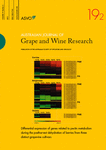Evaluation of single and dual crop coefficients over a drip-irrigated Merlot vineyard (Vitis vinifera L.) using combined measurements of sap flow sensors and an eddy covariance system
Abstract
Background and Aims
Irrigation is one of the most important viticultural practices in semi-arid regions. For this reason, the Food and Agriculture Organization's Irrigation and Drainage Paper No. 56 single and dual crop coefficient approaches were evaluated to estimate actual evapotranspiration (ETa) over a drip-irrigated Merlot vineyard.
Methods and Results
Vine transpiration was measured using sap flow sensors, and ETa was measured by an eddy covariance system. Soil evaporation was calculated as the difference between ETa and sap flow sensors. Reference evapotranspiration (ETo) was calculated using the Penman–Monteith equation. This information was used to evaluate single (Kc) and dual crop coefficients [Kcb and Ke] approaches during the 2007/08 and 2008/09 grapevine growing seasons.
Conclusions
Results indicated that vine transpiration is the most important component of ETa for a drip-irrigated Merlot vineyard trained on a vertical shoot-positioned system. In midseason, the observed values of single crop coefficients and Kcb were lower by 11 and 19% than those recommended by the Food and Agriculture Organization's Irrigation and Drainage Paper No. 56 for grapevines, respectively. The application of site-specific Kcb values reduced the error in the estimation of ETa by about 10%.
Significance of the Study
The study indicates that the use of sap flow sensors could be an alternative method for obtaining site-specific Kcb values for vineyards under field conditions.
Abbreviations
-
- ETa
-
- actual evapotranspiration
-
- ETo
-
- reference evapotranspiration
-
- Kc
-
- single crop coefficients
-
- Kcb
-
- basal crop coefficient
-
- Ke
-
- evaporation coefficient
-
- Tsap
-
- vine transpiration measured using sap flow sensors
-
- VSP
-
- vertical shoot positioned system
Introduction
One of the most important vineyard management practices in semi-arid regions is irrigation which is essential to ensure successful grape and wine production. The right amount of water at the appropriate time has a direct influence on wine quality (Sivilotti et al. 2005, Shellie 2006, Intrigliolo and Castel 2008). Irrigation scheduling is concerned with answering two basic questions: when do we irrigate and how much water do we need to apply? To achieve efficient irrigation management, it is necessary to have an accurate estimation of actual evapotranspiration (ETa). One accepted method for estimating ETa is the Food and Agriculture Organization's Irrigation and Drainage Paper No. 56 (FAO-56) (Allen et al. 1998) method (single and dual crop coefficient approaches) (Allen et al. 1998). This method has been extensively used to derive ETa and schedule irrigation for different crops (Allen et al. 2005). This method, due to its simplicity and robustness, has often been preferred for management purposes. Data requirements for applying this method are fewer than those necessary for mechanistic soil–plant–atmosphere models, and it provides a robust estimation of ETa when compared with ground-truth measurements (e.g. Paco et al. 2006, Er-Raki et al. 2007, 2008, 2009, Liu and Luo 2010).
The FAO-56 method is based on the concepts of reference evapotranspiration (ETo) and single crop coefficient (Kc), which have been introduced to separate climatic demand from plant response (Allen et al. 1998). With the FAO-56 method, ETa can be estimated using two approaches: (i) single crop coefficient approach (Kc), which represents the effect of both plant transpiration and soil surface evaporation; and (ii) dual crop coefficient approach (Kcb + Ke), which describes the relationship between ETa and ETo by separating Kc into basal crop coefficient (Kcb) and soil evaporation coefficient (Ke) (Allen et al. 1998, 2005). The plant transpiration component, represented by Kcb, corresponds to an index related to minimum soil evaporation conditions under no water restriction that would limit plant growth or transpiration (Wright 1982, Allen et al. 1998). Meanwhile, the soil evaporation component is represented by Ke. The FAO-56 dual crop coefficient approach has been used and tested over several sparse crops, such as cotton (Hunsaker et al. 2003, Howell et al. 2004), apples trees (Dragoni et al. 2004), peach orchard (Goodwin et al. 2006, Paco et al. 2006), olive orchard (Er-Raki et al. 2010), coffee trees (Flumignan et al. 2011) and grapevines (Campos et al. 2010). These examples show the increasing interest of the scientific community to use the FAO-56 dual crop coefficient approach for estimating ETa of vineyards and orchards under different climatic conditions and irrigation regimes. In this regard, studies carried out by Allen et al. (1998 2005) suggested that the dual crop coefficient approach is more suitable when the crops have a partial ground cover or are under highly frequent irrigation. On this matter, grapevines in most of the commercial vineyards in Chile are trained on a vertical shoot-positioned system (VSP) with a low fractional cover (fc) (around 30–40%) and are irrigated using drip irrigation systems with high irrigation frequency. This is a common feature in the main viticultural regions worldwide, particularly in viticulture areas of the young wine producing countries (Argentina, Australia, Canada, New Zealand, South Africa and the USA). Hence, the application of dual crop coefficients in vineyards under these conditions could be more appropriate for estimating ETa.
In general, Kc and Kcb values for grapevines can be obtained from the literature. These values are generic, however, are developed under different agro-climatic conditions and do not account for differences in canopy size, row orientation, training system or vine spacing, among others (Ortega-Farias et al. 2009). Therefore, the main objective of this research was to evaluate the FAO-56 method (single and dual crop coefficient approaches) for estimating ETa in a drip-irrigated Merlot vineyard trained on the VSP system under semi-arid conditions using combined measurements of sap flow sensors and an eddy covariance (EC) system.
Materials and methods
Study site
The study site was a drip-irrigated Merlot (Vitis vinifera L.) vineyard located in the Talca Valley, Maule Region, Chile (35°25′ LS; 71°32′ LW; 125 m.a.s.l.) during the 2007/08 and 2008/09 vine growing seasons. The Merlot grapevines (grafted on 101-14 Mgt) were planted (1999) in north-south rows with a distance between and within rows equal to 2.5 m and 1.5 m, respectively. The vines were trained on VSP with the main wire 1 m above the soil surface. Grapevines were irrigated daily using drippers of 4 L/h. Also, shoots of the grapevines were maintained in a vertical plain by three wires, with the highest one located 2 m above the soil surface.
The climate is Mediterranean semi-arid with an average daily temperature of 17.1°C and a mean annual rainfall of 679 mm. The summer period is usually dry and hot (2.2% of annual rainfall) while the spring is wet (16% of annual rainfall). The soil at the vineyard is classified as Talca series (fine, mixed, thermic Ultic Haploxeralfs) with a clay loam texture and an average bulk density of 1.5 g/cm3. At effective root-zone depth (0.6 m), the volumetric soil water content at field capacity (θfc) and wilting point (θwp) were 0.36 m3/m3 and 0.22 m3/m3, respectively (Table 1).
Complementary field measurements
Irrigation was scheduled considering a maximum allowed depletion (MAD) of 0.29 m3/m3 at the effective root-zone depth. The volumetric soil water content at the root-zone depth (θrd) was monitored weekly at 12 sampling points distributed inside the vineyard using a portable time domain reflectometry (TDR) unit (TRASE, Soil Moisture Corp., Santa Barbara, CA, USA). Furthermore, volumetric soil water content of the upper soil layer (0.1 m) was continuously monitored using a soil water content reflectometer (CS615, Campbell Scientific Inc., Logan, UT, USA).
Vine water status was evaluated weekly using the midday stem water potential (ψx) measured by a pressure chamber (PMS600, PMS Instruments Company, Corvallis, OR, USA). The ψx was measured on 12 young, fully expanded leaves (two leaves per vine), wrapped in aluminium foil and encased in plastic bags at least 2 h before measurement (Choné et al. 2001). This parameter was used to evaluate the level of water stress in the vineyard (Williams and Trout 2005, Sibille et al. 2007).
The average fractional cover (fc) of the vineyard was estimated ten times during each season by measuring the projected area occupied by the vine (fraction of ground shaded by the vertical projection of the canopy at midday), using digital images. The analysis of the digital images (white and black pixel count) was made using a script written in MATLAB® 2009a (The Mathworks Inc., Natick, MA, USA).
Sap flow measurements
Vine transpiration (Tsap) was determined using sap flow sensors (700 SF-100, Tranzflo, Palmerston North, New Zealand) inserted in the trunk of eight vines (one sap flow sensor per vine), with a similar trunk diameter near to the EC system. Vine canopy transpiration was determined by the compensated heat-pulse velocity method (Green et al. 2003, Alarcon et al. 2005, Poblete-Echeverría et al. 2012). The upstream sensor probe (xu) was located 5 mm below the heater probe, and the downstream sensor (xd) was located 10 mm above the heater probe. On each sensor, there are three thermistors, positioned at 5 mm, 10 mm and 15 mm. A data logger (CR23X, Campbell Scientific Inc., Logan, UT, USA) was used to trigger heat pulses and record the time interval between the initiation of a heat pulse and equilibration between upstream and downstream temperature (tz). Heat pulses of 0.75 s were automatically triggered every hour throughout the day. For this experiment, the sap flow measurements were evaluated by Poblete-Echeverría et al. (2012) using residual transpiration (Tr) obtained by combined measurements of the EC system and microlysimeters. This study showed a good agreement between Tsap and Tr with a root mean square error (RMSE) equal to 0.22 mm/day when a correction coefficient for a wound size of 2.4 mm was applied.
Meteorological measurements
 (1)
(1)Micrometeorological measurements
ETa was obtained using an EC system (ETa_ec) installed 4.7 m above the soil surface. Fluxes of latent (LE) and sensible (H) heat were registered with an infrared gas analyser (LI-7500, Li-Cor Biosciences, Lincoln, NB, USA) and a sonic anemometer (CSAT3, Campbell Scientific Inc., Logan, UT, USA). Vineyard soil heat flux (G) was measured by eight soil heat flux plates of constant thermal conductivity (HFT3, Campbell Scientific Inc., Logan, UT, USA) and four pairs of thermocouples. The heat stored above the plates was added algebraically to the fluxes measured by the flux plates (Ortega-Farias et al. 2010). Net radiation over the vineyard (Rn) was measured at 4.7 m by a four-way net radiometer (CNR1, Kipp & Zonen Inc., Delft, The Netherlands). The accuracy of the EC system measurements was evaluated using the energy balance ratio calculated on a daily basis. More details about the distribution and configuration of the sensors are described by Poblete-Echeverría and Ortega-Farias (2009).
Single and dual crop coefficient using the FAO-56 approach
 (2)
(2) (3)
(3)Following the segment approach proposed by the FAO-56, the vine growing seasons were divided into four growth stages: (i) the initial stage (Lini); (ii) crop development stage (Ldev); (iii) midseason stage (Lmid); and (iv) late season stage (Llate). Lini and Lmid are characterised by horizontal line segment while Ldev and Llate are characterised by rising and falling line segments, respectively (Figure 5). A piecewise line function (SigmaPlot v12.0; Systat Software GmbH, Erkrath, Germany) was used to obtain the average value of Kc and Kcb at the initial, midseason and late growing stage. The FAO-56 and observed length of growth stages for the vineyard are given in Table 2. In the segment approach, three critical Kc and Kcb values are required to generate the entire Kc and Kcb curves during the vine growing season. The recommended values of Kc and Kcb presented by Allen et al. (1998) for the different vine development stages are given in Table 3.
| Source | Length of growth stages (days) | Total length | |||
|---|---|---|---|---|---|
| Lini | Ldev | Lmid | Llate | ||
| Recommended by FAO-56 | 30 | 60 | 40 | 80 | 210 |
| Observed 2007/08 | 31 (132) | 47 (478) | 63 (1205) | 50 (1641) | 192 |
| Observed 2008/09 | 38 (174) | 41 (555) | 62 (1241) | 42 (1653) | 184 |
| Observed average | 35 (153) | 44 (517) | 63 (1223) | 46 (1647) | 188 |
- The cumulative growing degree days (GDD) are shown in brackets. Lini is the initial stage, Ldev is the crop development stage, Lmid is the midseason stage and Llate is the late season stage. FAO-56 (Allen et al. 1998).
| Single crop coefficient | Basal crop coefficient | |||||
|---|---|---|---|---|---|---|
| Source | Kc_ini | Kc_mid | Kc_late | Kcb_ini | Kcb_mid | Kcb_late |
| Recommended by FAO-56 | 0.30 | 0.70 | 0.45 | 0.15 | 0.65 | 0.40 |
| Observed value | Kc_ec_ini | Kc_ec_mid | Kc_ec_late | Kcb_sap_ini | Kcb_sap_mid | Kcb_sap_late |
| Season 2007/08 | 0.39 | 0.60 | 0.58 | 0.27 | 0.50 | 0.43 |
| Season 2008/09 | 0.34 | 0.64 | 0.53 | 0.20 | 0.55 | 0.43 |
 (4)
(4) (5)
(5) (6)
(6) (7)
(7) (8)
(8) (9)
(9) (10)
(10)Statistical analysis
In this study, ETa was computed by three approaches: (i) using Kc values and length of growth stages (L) values recommended by the FAO-56 (ETa_sc FAO-56 = Kc ETo); (ii) using dual crop coefficients and L-values recommended by the FAO-56 (ETa_dc FAO-56 = (Kcb + Ke) ETo); and (iii) using Kcb_sap and observed values of L (ETa_dc SAP = (Kcb_sap + Ke_sap) ETo). Recommended and observed values of L, single and dual coefficients are indicated in Tables 2 and 3. Computed ETa values were compared with those obtained by the EC system (ETa_ec). The statistical comparison included a linear regression analysis, the RMSE, mean absolute error (MAE), model efficiency (EF) and index of agreement (d) (Table 4) (Willmott 1982, Mayer and Butler 1993, Legates and McCabe 1999).
| Statistical parameters | Symbol | Equation | Optimum |
|---|---|---|---|
| Root mean square error | RMSE |

|
0 |
| Mean absolute error | MAE |

|
0 |
| Model efficiency | EF |

|
1 |
| Index of agreement | d |

|
1 |
- where N is the total number of observations, Ei and Oi are the estimated and observed values, respectively, and
 is the mean of the observed values.
is the mean of the observed values.
Results and discussion
Weather conditions
Growing seasons experienced in this study were dry and hot with average air temperature (Ta) equal to 18.5°C during the 2007/08 season and 19.6°C during the 2008/09 season. The average daily value of the vapour pressure deficit (VPD) was similar during both seasons at around 1.0 kPa. Maximum values of VPD were around 1.6 kPa during the first season and 1.8 kPa during the second season (Figure 1). The average value of wind speed (u) was 0.9 m/s and 1.36 m/s for the first and second seasons, respectively. Temporal patterns of rainfall over both vine growing seasons were characterised by low and irregular rain events, with a total PP amount (from DOY274 to DOY100) of 11.6 mm during the 2007/08 season and only 3.2 mm (from DOY271 to DOY89) during the 2008/09 season.

Seasonal variation of vapour pressure deficit (VPD) over the whole grapevine growing season for (a) 2007/08 and (b) 2008/09.
Soil and plant water status
The average value of θrd measured by TDR was similar during both seasons, with an average around 0.31 m3/m3 (Figure 2). This soil moisture value is an indication that the Merlot vineyard was well irrigated, with θrd maintained between θfc and MAD levels. The average value of ψx ranged between −0.42 and −1.0 MPa and −0.66 and −1.1 MPa during the first and second season, respectively (Figure 2). These values showed that the Merlot vineyard was not under water stress during the study period (Williams and Trout 2005, Sibille et al. 2007).
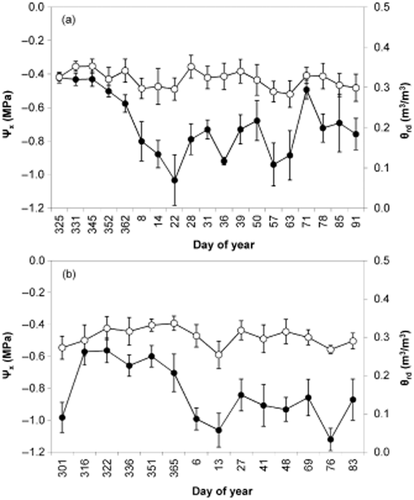
Midday steam water potential (ψx, •) and volumetric soil water content at the rooting depth (θrd, ○) for (a) 2007/08 and (b) 2008/09 seasons. Vertical error bars represent standard deviation.
Surface energy balance closure
Based on the first law of thermodynamics (conservation of energy), the accuracy of the EC system to measure turbulent fluxes was evaluated using the energy balance closure, which is a linear regression between turbulent energy fluxes (H + LE) and available energy (Rn−G) (Baldocchi et al. 2000, Twine et al. 2000, Wilson et al. 2002). Figure 3 shows the energy balance closure over a drip-irrigated Merlot vineyard for the 2007/08 and 2008/09 seasons. This figure indicates that the comparison points were close to line 1:1, presenting an acceptable energy balance closure with a slope passing through the origin (b) equal to 0.88 for both seasons. Also, the value of the determination coefficient (r2) was 0.95 and 0.88 for the first and second seasons, respectively. The analysis of surface energy balance closure indicates that the turbulent fluxes were about 12% less than the available energy for the two seasons. This value represents a good energy balance closure, which is in agreement with other studies that present a lack of energy balance closure between 10 and 30% (Baldocchi et al. 2000, Twine et al. 2000, Testi et al. 2004). Similar results were found by Spano et al. (2004) and Poblete-Echeverría and Ortega-Farias (2012) who indicated an imbalance of 16% and 11% for drip-irrigated Sangiovese and Merlot vineyards, respectively.
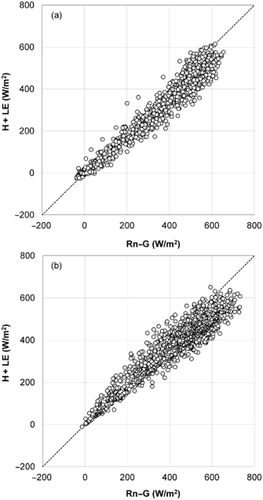
Comparison between sensible heat flux plus latent heat flux (H + LE) versus net radiation minus soil heat flux (Rn–G) over 30-min intervals for (a) 2007/08 and (b) 2008/09 seasons. Dashed line represents 1:1 line.
Reference and ETa
Seasonal variations of ETo and ETa_ec are shown in Figure 4 for the 2007/08 and 2008/09 seasons, respectively. These figures shows that the ETo temporal pattern is typically associated with a semi-arid climate belonging to the southern hemisphere, which is characterised by a high ETo value in December with a maximum value of 7.3 mm/day during the first season and 6.9 mm/day during the second season (Table 5). Accumulated ETo for the first (between DOY274 and DOY100) and second (DOY271 and DOY89) seasons were 839.1 and 872.3 mm, respectively. Furthermore, the ETa_ec value measured by the EC system ranged from 2.0 mm/day, early in the season, when the shoots were growing, to a value of around 5 mm/day when vines reached full cover (fc ≈ 30%). The mean ETa_ec value obtained in this study was 2.6 mm/day during the first season and 2.9 mm/day during the second season (Table 5). These values are in agreement with those reported in literature for grapevines (Oliver and Sene 1992, Evans et al. 1993, Trambouze et al. 1998, Yunusa et al. 2004, Williams and Ayars 2005, Ortega-Farias et al. 2010).
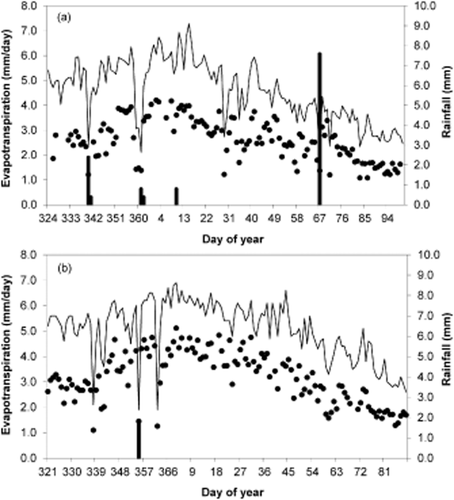
Daily reference evapotranspiration (ETo,  ) calculated using the FAO-56 Penman–Monteith equation and actual evapotranspiration measured by the eddy covariance system (ETa_ec, •) during (a) 2007/08 and (b) 2008/09 seasons. Rainfall events are shown in black bars.
) calculated using the FAO-56 Penman–Monteith equation and actual evapotranspiration measured by the eddy covariance system (ETa_ec, •) during (a) 2007/08 and (b) 2008/09 seasons. Rainfall events are shown in black bars.
| Variable | Mean | Minimum | Maximum | Range |
|---|---|---|---|---|
| Season 2007/08 | ||||
| ETo | 4.4 | 1.8 | 7.3 | 5.5 |
| ETa_ec | 2.6 | 1.1 | 4.2 | 3.1 |
| Tsap | 2.2 | 1.2 | 3.4 | 2.2 |
| Eec_sap | 0.6 | 0.1 | 1.3 | 1.2 |
| Season 2008/09 | ||||
| ETo | 4.7 | 1.3 | 6.9 | 5.6 |
| ETa_ec | 2.9 | 0.4 | 5.1 | 4.7 |
| Tsap | 2.4 | 0.3 | 4.3 | 4.0 |
| Eec_sap | 0.5 | 0.1 | 1.3 | 1.2 |
- Mean is the average value (mm/day); minimum is the minimum value (mm/day); maximum is the maximum value (mm/day); range is the difference between maximum and minimum (mm/day).
Single crop coefficient
Observed Kc values (Kc_ec) for the vineyard were obtained using Equation 8. At the initial stage of crop growth (Kc_ec_ini), the value was low, but increased with crop development and remained almost constant at full canopy cover (Table 3). Recommended (Kc_ini, Kc_mid and Kc_late) and observed values (Kc_ec_ini, Kc_ec_mid and Kc_ec_late) are presented in Table 3. The mean value of observed Kc_ec at the initial stage for the 2007/08 and 2008/09 seasons was higher than that recommended by the FAO-56 (Kc_ini = 0.30). On the contrary, Kc_ec_mid for the 2007/08 and 2008/09 seasons (0.60 and 0.64) were lower than those recommended by FAO-56 (Kc_mid = 0.70) (Table 3). This lower Kc_ec value at the mid-growth stage is attributed to low fractional cover (fc ≈ 30%) observed in this study. In this regard, Allen and Pereira (2009) proposed new values of Kc_mid for grapevines depending on fractional cover and height, corresponding to a Kc_mid of 0.64 (no stress conditions) and a Kc_mid of 0.45 (for stressed vines with a stress coefficient of 0.7) for low density grapevines (fc = 25%). Similar results were observed by Montoro et al. (2008), who reported a monthly mean Kc around 0.65 at peak vegetation cover for daily drip-irrigated grapevines cv. Cencibel using a weighing lysimeter. In addition, Williams and Ayars (2005) developed a linear relation for Thompson Seedless to obtain a single crop coefficient as a function of fc (Kc = −0.008 + 0.017fc). This approach has a strong practical implication because techniques for the measurement of fc and leaf area index (LAI) have been advanced lately using digital imaging analysis (e.g. Fuentes et al. 2008). Finally, the values of Kc_ec_late obtained in this study were 0.58 and 0.53 for first and second seasons, respectively. These values were higher than those recommended by the FAO-56 (Kc_late = 0.45).
Also, in seasonal terms, ETa_ec presented a significant linear relationship with ETo (Figure 4). The linear regression obtained (forced to pass through the origin) between ETa_ec and ETo presented a determination coefficient (r2) of 0.76 and a slope (b) of 0.58 for the first season and r2 equal to 0.69 and b equal to 0.61 for the second season. In this case, b-values represent a whole value of Kc_ec which are similar to average values at the midgrowth stage (Table 3).
Dual crop coefficient
Vine transpiration measured by sap flow sensors (Tsap) ranged between 1.2 and 3.4 mm/day for the first growing season with a mean value of 2.2 mm/day. In the second season, the Tsap value ranged between 0.3 and 4.3 mm/day with a mean value of 2.4 mm/day (Table 5). These results are similar to those registered by other studies (Eastham and Gray 1998, Yunusa et al. 2004). Also, Tsap values presented a significant linear relationship when compared with ETo values (Figure 6). The linear regression obtained (forced to pass through the origin) between Tsap and ETo presented a determination coefficient (r2) of 0.75 and a slope (b) of 0.47 for the first season and r2 equal to 0.64 and b equal to 0.50 for the second season. These results are in accordance with other studies, which found a linear relationship between Tsap and ETo for well-irrigated olive trees (Fernández et al. 2001, Rousseaux et al. 2009), apricot trees (Nicolas et al. 2005) and lemon trees (Ortuño et al. 2006).
In this study, Tsap values were used to calculate new critical values to generate the entire Kcb curve during the whole vine growing season. Figure 5 shows a comparison between recommended and observed Kcb curves for the different growth stages: initial (Kcb_ini, budburst to 10% of full effective cover), development (Kcb_dev, 10% of full effective cover), midseason (Kcb_mid, from full effective cover to full maturity) and late season (Kcb_late, from full maturity to harvest of grapes). From Figure 5a, it can be seen that the observed Kcb at the initial growth stage (Kcb_ini = 0.27) is higher than that recommended by the FAO-56 (0.15). Also, the value of Kcb_mid (0.55) is lower than that recommended by the FAO-56 (0.65). Finally, the value of Kcb_late (0.43) is slightly higher than that recommended by the FAO-56 (0.40). Similar differences were found in the second season (Figure 5b) where the observed values of Kcb_ini, Kcb_mid and Kcb_late were equal to 0.20, 0.55 and 0.43, respectively. Following, the approach proposed by Williams and Ayars (2005) for obtaining a single crop coefficient, sap flow sensors could be used to characterise Kcb and relate them to fc or LAI for obtaining site-specific relation between these variables.
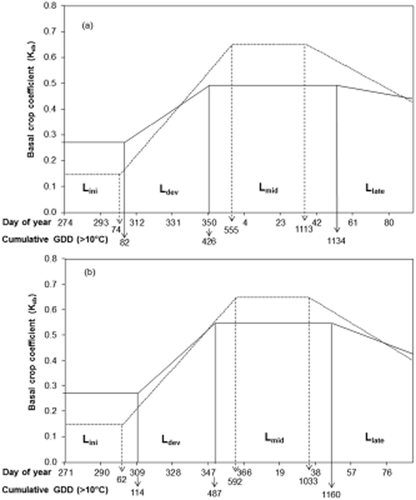
FAO-56 ( ) and observed (
) and observed ( ) lengths of initial, (Lini) development (Ldev) midseason (Lmid) and late (Llate) growing stages for (a) 2007/08 and (b) 2008/09 seasons. Arrows represent the cumulative growing degree days GDD (>10°C).
) lengths of initial, (Lini) development (Ldev) midseason (Lmid) and late (Llate) growing stages for (a) 2007/08 and (b) 2008/09 seasons. Arrows represent the cumulative growing degree days GDD (>10°C).
The length of the Merlot vineyard growth stages during the 2007/08 and 2008/09 seasons is shown in Table 2. The length of the initial growth stage (Lini) was between 31 and 38 days, which differed by 1 and 8 days more than the length considered by the FAO-56. The developing growth stage, however, was shorter than that considered by the FAO-56 for both study seasons with a difference of 13 and 19 days for the 2007/08 and 2008/09 seasons, respectively. The midseason growth stage observed in this study was significantly longer than the length considered by the FAO-56 with a difference of 23 and 22 days for the first and second seasons, respectively. The length of the late growth stage (Llate) was 30 and 38 days shorter than values considered by the FAO-56. Finally, the total length of the vine growing season observed in this study was 192 and 184 days for the 2007/08 and 2008/09 seasons, respectively. These values were shorter than those suggested by the FAO-56 (210 days) with a difference of 18 for the 2007/08 season and 26 days for the 2008/09 season. The differences in the length of growing stages between the experimental seasons compared with those considered in the FAO-56 may be attributed to climatic conditions at the study site. In this regard, several recent studies have reported that climate change is expected to have a significant impact on the length of the growing season because of an increased temperature (Jones et al. 2005, Webb et al. 2007, Caffarra and Eccel 2011, Tomasi et al. 2011). Webb et al. (2007), using warming projections based on future greenhouse gas emission scenarios and patterns of climate change, reported that season duration (from budburst to harvest) will be compressed in all Australian vineyard regions resulting in early harvests. In Chile, this effect is not clear because of the influence of the ‘El Niño-Southern Oscillation’ (ENSO). ENSO events include Niño events, which are characterised by high rainfall and moderate temperatures, and Niña events that produce the opposite effects, droughts and high temperatures.
One problem in determining the length of growth stages in chronological time is that data are not transferable to other agro-climatic locations. One solution is to express Kcb curves in terms of GDD (de Medeiros et al. 2001). GDD values for the two study seasons are presented in Table 2. The second season shows slightly more cumulative GDD than the first season, completing the vine growth in less time. The cumulative GDD in the total vine growth periods, however, was similar for both seasons (Table 2). The differences between seasons with respect to the length of growth stages can be explained by the changes in climatic conditions during specific periods. In the season 2007/08 (Niña), the bud-break was 6 days after that of the 2008/09 season (normal).
The average value of Eec_sap found in this study was similar during both seasons. In the first season, the Eec_sap value ranged from 0.1 to 1.3 mm/day with an average value of 0.6 mm/day. In the second season, the Eec_sap value ranged from 0.1 to 1.3 mm/day with an average value of 0.5 mm/day (Table 5). The ratio of Eec_sap to ETa found in this study was 0.23 during the first season and 0.17 during the second season. Also, the whole evaporation coefficient calculated by a lineal regression analysis was 0.12 and 0.11 for first and second season, respectively. Unlike what happened with the relation between ETo and ETa_ec, the r2 value in the relation between ETo and Eec_sap was low with values of 0.38 and 0.26 for the first and second season, respectively (Figure 6). A low r2 value can be related to a low (mean value less than 0.6 mm/day), and relatively constant (standard deviation less than 0.31 mm/day) value of soil evaporation. In the same experimental plot, values of Es measured by microlysimeters were reported by Poblete-Echeverría et al. (2012) who indicated that the Es value ranged from 0.28 to 1.14 mm/day during the season 2007/08 and from 0.37 to 1.04 mm/day during the 2008/09 season.

Ratio of vine transpiration estimated by sap flow sensors (Tsap, □), actual evapotranspiration measured by the eddy covariance system (ETa_ec, •) and residual soil evaporation (Eec_sap, ○) to reference evapotranspiration (ETo) during (a) 2007/08 and (b) 2008/09 seasons.
Eec_sap values calculated in this study are similar to those found by Yunusa et al. (2004) in Australia, who presented an average value of 0.4 mm/day in a drip-irrigated Sultana vineyard in a dry period (no rainfall or irrigation events), which corresponds to 21% of ETa and only 3% of ETo. For the irrigated period, Yunusa et al. (2004) found an average value of Es of 1.6 mm/day which represents 26 and 64% of ETo and ETa, respectively. For a partial root-zone, furrow-irrigated Merlot vineyard in China, Zhang et al. (2009) indicated that the value of Es measured by microlysimeters was around 2.2 mm/day for the 6 consecutively days after irrigation. In Brazil, Teixeira et al. (2007) found that for drip-irrigated grapevines cv. Petite Syrah, Es was from 8 to 9% of ETo and from 11 to 12% of ETa. In the same study, for the table grape cv. Superior Seedless with microsprinkler irrigation Es was from 15 to 19% of ETo and from 17 to 21% of ETa.
Estimation of ETa
Figure 7 shows the comparison between ETa_ec and ETa simulated by the three approaches studied (ETa_sc FAO-56, ETa_dc FAO-56 and ETa_dc SAP). In the first season when recommended values of Kc are used, the single crop coefficient approach (ETa_sc FAO-56) tended to overestimate ETa_ec (Figure 7a). In the second season, however, the comparison between ETa_sc FAO-56 versus ETa_ec (measured value) was improved, with points close to 1:1 line (Figure 7b). Likewise, when recommended values of Kcb and L are used, the dual crop coefficient approach tended to overestimate ETa especially for high values (over 3 mm/day) (Figure 7). When the observed values of Kcb and L are used (ETa_dc SAP), however, the dual crop coefficient approach shows that points were uniformly distributed around the 1:1 line (Figure 7).
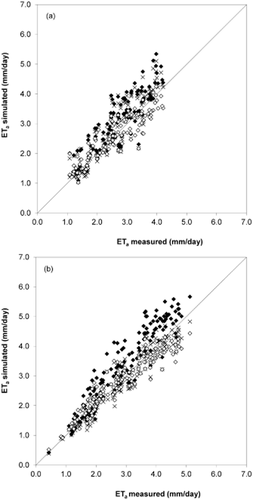
Comparison between actual evapotranspiration (ETa) obtained from the eddy covariance system (ETa_ec) and computed by: single crop coefficient approach using recommended values (ETa_sc FAO-56, x) dual crop coefficients approach, using recommended values (ETa_dc FAO-56, ♦) and using observed basal crop coefficients values (ETa_dc SAP, ◊) for the (a) 2007/08 and (b) 2008/09 seasons. Solid line represents 1:1 line.
Figure 8 shows a seasonal daily comparison between ETa observed and calculated by the three approaches studied from DOY326 to DOY99 for the first season and from DOY296 to DOY89 for the second season. There is good agreement between observed and estimated ETa values during both vine growing seasons. Some discrepancies between observed and simulated ETa values can be seen after rainfall events and stress periods in the first season (Figure 8a).
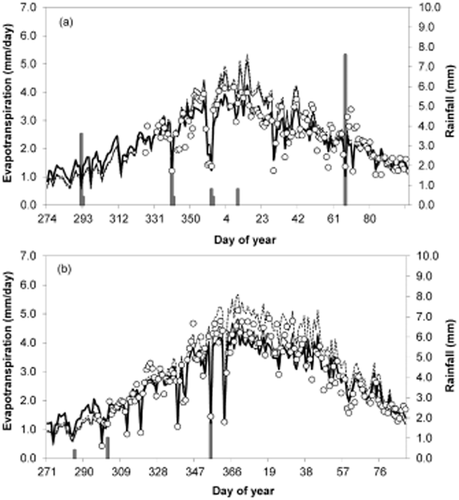
Daily comparison of actual evapotranspiration measured by the eddy covariance system (ETa_ec, ○) and computed by the single crop coefficient approach using recommended values (ETa_sc FAO-56,  ), the dual crop coefficients approach, using recommended values (ETa_dc FAO-56,
), the dual crop coefficients approach, using recommended values (ETa_dc FAO-56,  ) and using observed basal crop coefficients values (ETa_dc SAP,
) and using observed basal crop coefficients values (ETa_dc SAP,  ) for the (a) 2007/08 and (b) 2008/09 seasons. Rainfall events, in grey bars, are shown as a reference.
) for the (a) 2007/08 and (b) 2008/09 seasons. Rainfall events, in grey bars, are shown as a reference.
For rainfall events, the difference between measured and simulated ETa values may be explained by uncertainties in the measurements of the EC system (Er-Raki et al. 2010) and by problems associated with the estimation of soil evaporation, when the soil surface reaches water saturation after the rainfall event. This effect is corroborated by Liu and Luo (2010) who found that the dual approach of the FAO-56 is appropriate for estimating the total quantity of evapotranspiration, but inaccurate when simulating the peak value after PP or irrigation.
The summer period in Chile is characteristically dry. So, in this study, only one rainfall event of 7.6 mm (season 2007/08) produced an underestimation of ETa_ec of about 23% in the case of the ETa_dc SAP approach; 19% in the case of the ETa_sc FAO-56 approach; and 15% in the case of ETa_dc FAO-56. In general, the experimental plots were well irrigated, however, near veraison, the ψx reached values lower than −1.0 MPa (Figure 2), which indicated a mild stress for this period. This stress level could lead to the dual crop coefficient approach overestimating ETa compared with the EC system because of an overestimation of the soil water stress coefficient (Er-Raki et al. 2010). For example, for the stress period of the first season (DOY17 to DOY26), the single crop coefficient approach using recommended values of Kc and L tended to overestimate ETa_ec by about 22%; the dual crop coefficient approach using recommended values of Kcb and L tended to overestimate ETa_ec by about 26% and the dual crop coefficient approach using observed values of Kcb and L tended to overestimate ETa by only 3%.
The performance of single and dual crop coefficient approaches to estimate ETa over daily periods is shown in Table 6. The statistical analysis indicates that the single crop coefficient approach using recommended values of Kc and L was able to predict ETa_ec with overall values of r2, EF and d equal to 0.83, 0.78 and 0.95, respectively. So, the single crop coefficient approach using recommended values of Kc and L produces a good estimation of ETa_ec with a low absolute error 0.35 mm/day (12.8% error). In the case of dual crop coefficient approach using recommended values of Kcb and L, the statistical analysis presented in Table 6 shows that this approach had a lower agreement with values of ETa_ec showing overall values of r2, EF and d equal to 0.86, 0.52 and 0.91, respectively. Also, the overall values of RMSE and MAE were 0.69 mm/day (24.8% error) and 0.54 mm/day (19.6% error), respectively (Table 6). However, the dual crop coefficient approach using observed values of Kcb and L showed the best estimation of ETa_ec with overall values of r2, EF and d equal to 0.87, 0.86 and 0.96, respectively. Also, overall values of RMSE and MAE were, respectively, 0.37 (13.2% error) and 0.28 mm/day (10.3% error) (Table 6). This analysis indicated that the use of sap flow sensors for obtaining site-specific Kcb values in the dual crop coefficient approach reduces the RMSE values from 0.69 to 0.37 mm/day (46% of error reduction) and MAE values from 0.54 to 0.28 mm/day (48% of error reduction).
| Season | a | b | r2 | RMSE | MAE | EF | d |
|---|---|---|---|---|---|---|---|
| ETa_sc FAO-56 | |||||||
| 2007/08 | 0.16 | 1.06 | 0.78 | 0.57 (21.7) | 0.45 (17.2) | 0.54 | 0.90 |
| 2008/09 | 0.10 | 0.97 | 0.90 | 0.36 (16.5) | 0.27 (9.4) | 0.89 | 0.97 |
| Overall | 0.21 | 0.98 | 0.83 | 0.47(16.8) | 0.35 (12.8) | 0.78 | 0.95 |
| ETa_dc FAO-56 | |||||||
| 2007/08 | 0.22 | 1.09 | 0.79 | 0.67 (25.5) | 0.50 (19.2) | 0.36 | 0.88 |
| 2008/09 | 0.12 | 1.14 | 0.89 | 0.71 (24.2) | 0.58 (19.8) | 0.58 | 0.92 |
| Overall | 0.15 | 1.13 | 0.86 | 0.69 (24.8) | 0.54 (19.6) | 0.52 | 0.91 |
| ETa_dc SAP | |||||||
| 2007/08 | 0.54 | 0.80 | 0.79 | 0.39 (14.9) | 0.30 (11.6) | 0.78 | 0.90 |
| 2008/09 | 0.45 | 0.87 | 0.91 | 0.34 (11.8) | 0.27 (9.3) | 0.90 | 0.97 |
| Overall | 0.46 | 0.85 | 0.87 | 0.37 (13.2) | 0.28 (10.3) | 0.86 | 0.96 |
- a is the intercept (mm/day); b is the slope (dimensionless); r2 is the determination coefficient; RMSE is the root mean square error (mm/day); MAE is the mean absolute error (mm/day); EF is the model efficiency (dimensionless); d is the index of agreement (dimensionless). Values in brackets for RMSE and MBE represent relative root mean square error (rRMSE) (%) and relative mean bias error (rMAE) (%), respectively. ETa_sc FAO-56 = EToKc; and ETa_dc FAO-56 = ET0(Kcb + Ke) and ETa_dc SAP = ET0(Kcb_sap + Ke) where ETo is the reference evapotranspiration, Ke is the soil coefficient, Kc, Kcb are the single and basal coefficient recommended by FAO56 and Kcb_sap is the basal coefficient obtained by sap flow measurements.
Recent studies in orchards have shown a good correlation between ETa estimated by the dual crop coefficient approach and ETa measured by the EC system. For example, Paco et al. (2006), using an EC system in a peach orchard, found a good correlation with a slope of 0.77 and r2 equal to 0.73. Using the same comparison method in an olive orchard, Er-Raki et al. (2010) found that the dual crop coefficient approach estimated ETa with an RMSE of 0.54 and 0.71 mm/day for the 2003 and 2004 seasons, respectively. Several studies, however, have emphasised the need to calibrate the Kcb values by comparing them with measurements obtained locally (Carr 2001, Flumignan et al. 2011). Dragoni et al. (2004), in an apple orchard, showed a significant overestimation (over 15%) of Kcb by the FAO-56 method compared with sap flow measurements. Paco et al. (2006) calculated a mean Kcb of 0.5 which is less than that suggested by the FAO-56 for peach orchards (Kcb = 0.7).
Conclusions
The objective of this study was to evaluate the FAO-56 single and dual crop coefficient approaches for estimating ETa in a drip-irrigated Merlot vineyard under semi-arid conditions. Results indicated that soil evaporation was 20% of ETa_ec and 11% of ETo for whole growing season, suggesting that Tsap is the most important component of ETa for a drip-irrigated Merlot vineyard trained on a VSP. In this study the observed values of Kc and Kcb for midseason stage (Kc_ec_mid and Kcb_sap_mid) under no stress conditions were between 0.60−0.64 and 0.50−0.55, respectively. These values were lower than those recommended by the FAO-56 for grapevines for this period, which indicated that these coefficients are related to site-specific conditions. Statistical analysis indicated that single and dual crop coefficients recommended by the FAO-56 estimate ETa with an RMSE equal to 0.47 and 0.69 mm/day and a MAE equal to 0.35 and 0.54 mm/day, respectively. These values represent around 17 and 25% of error in the estimation of ETa for single and dual crop coefficients, respectively.
On the other hand, results show that the use of local Kcb and L-values improves the estimation of ETa with an RMSE equal to 0.37 mm/day and a MAE equal to 0.28 mm/day. These results indicated that Kc and Kcb values require a site-specific calibration because they depend on vigour, training system and canopy management. In this regard, the use of sap flow sensors could be an alternative method for obtaining site-specific Kcb values for vineyards under field conditions.
Acknowledgements
The research leading to this report was supported by the Chilean government through the projects FONDECYT POSTDOCTORAL (N°3100128), CONICYT (N°79090035), FONDECYT (1071040) and Universidad de Talca (Programa de Investigación sobre Adaptación de la Agricultura al Cambio Climático – PIEI).



